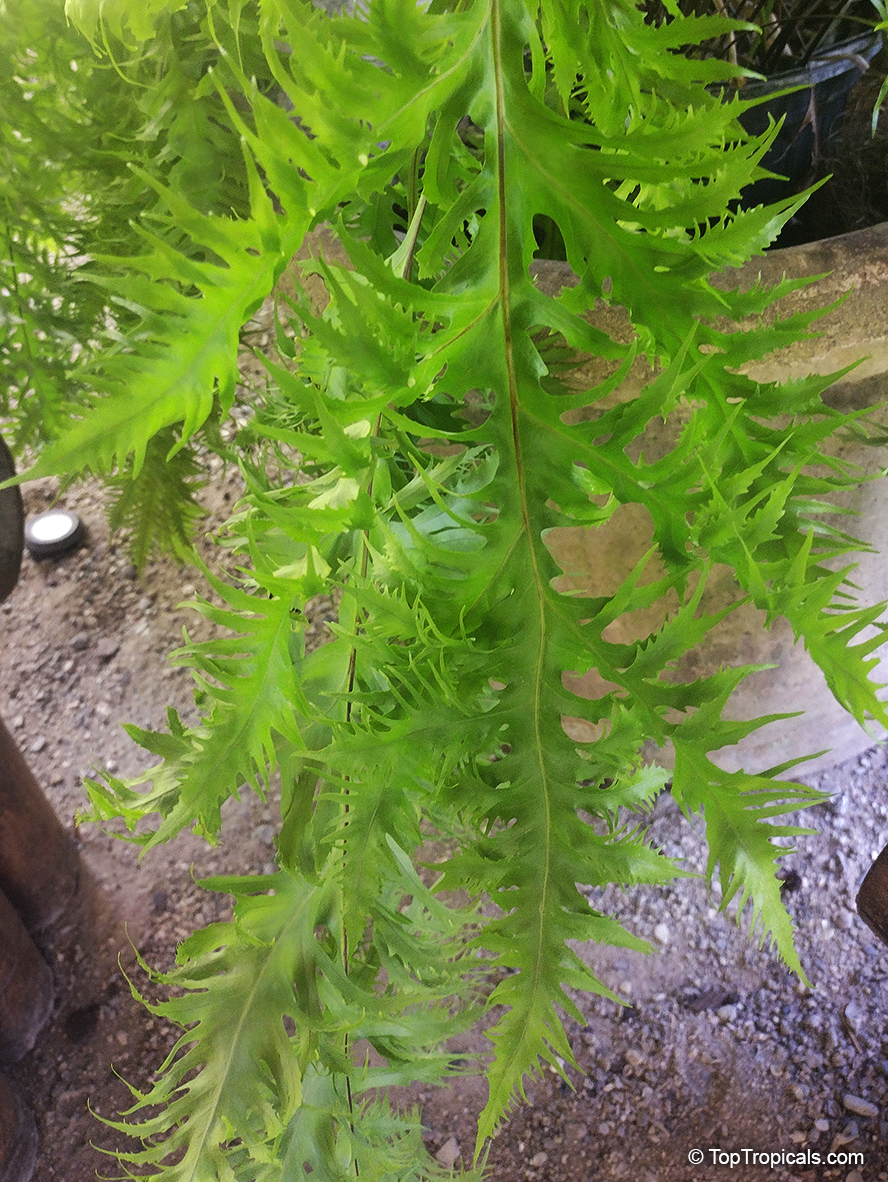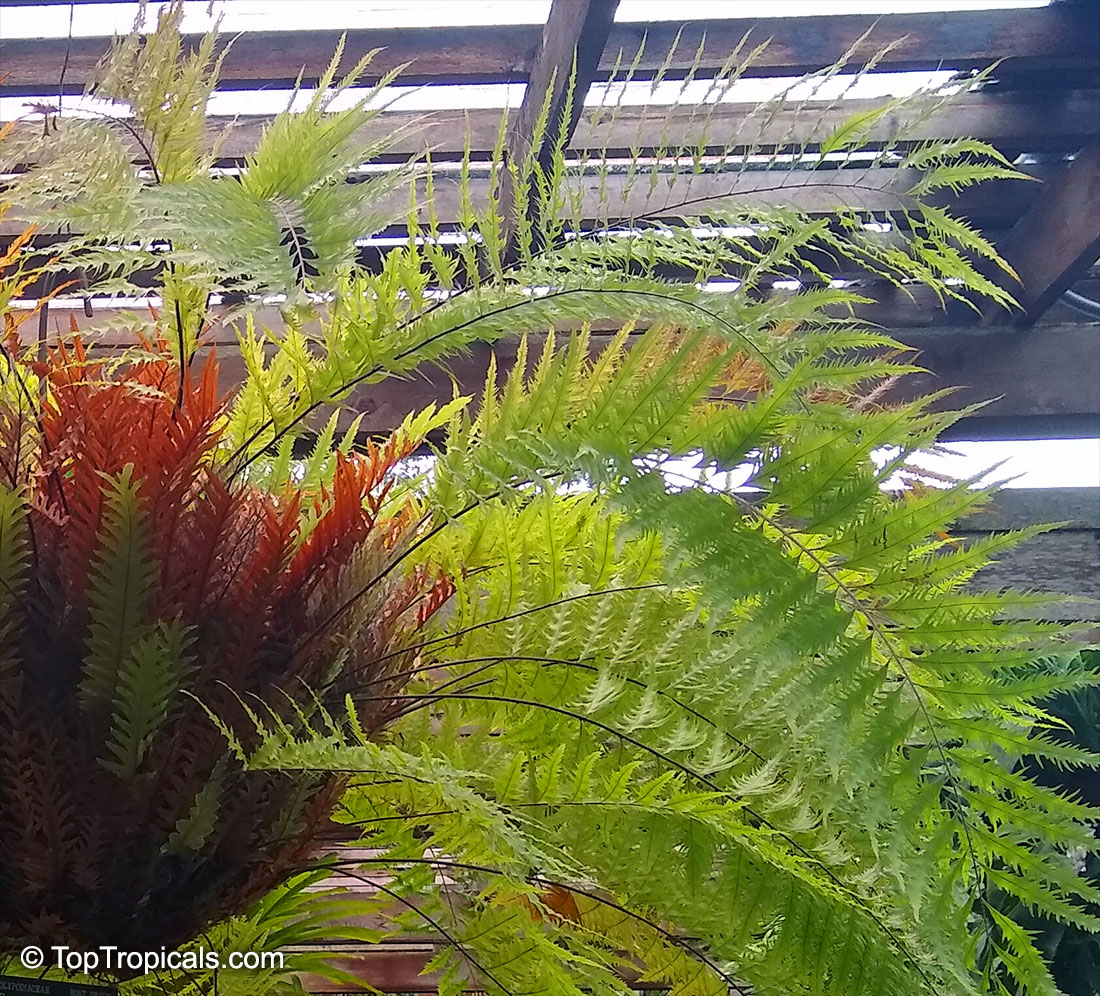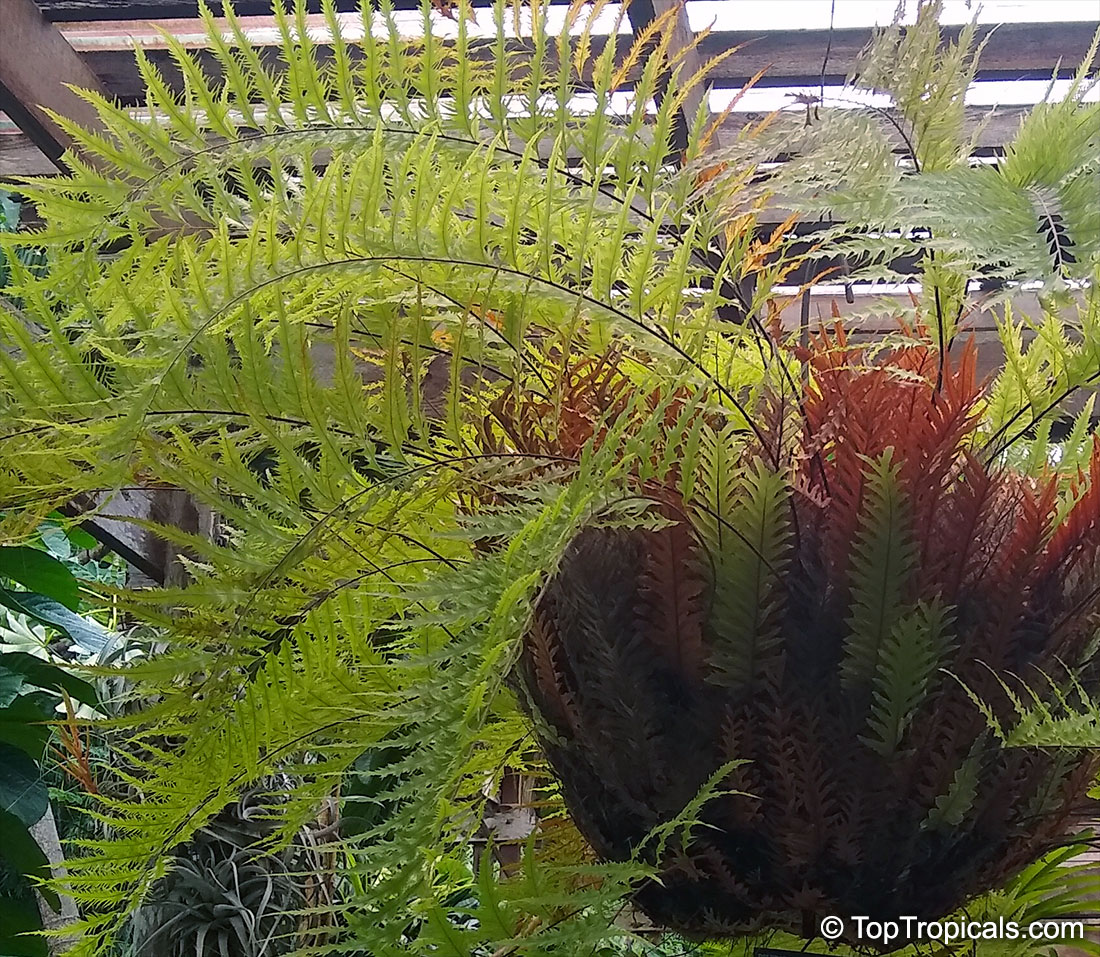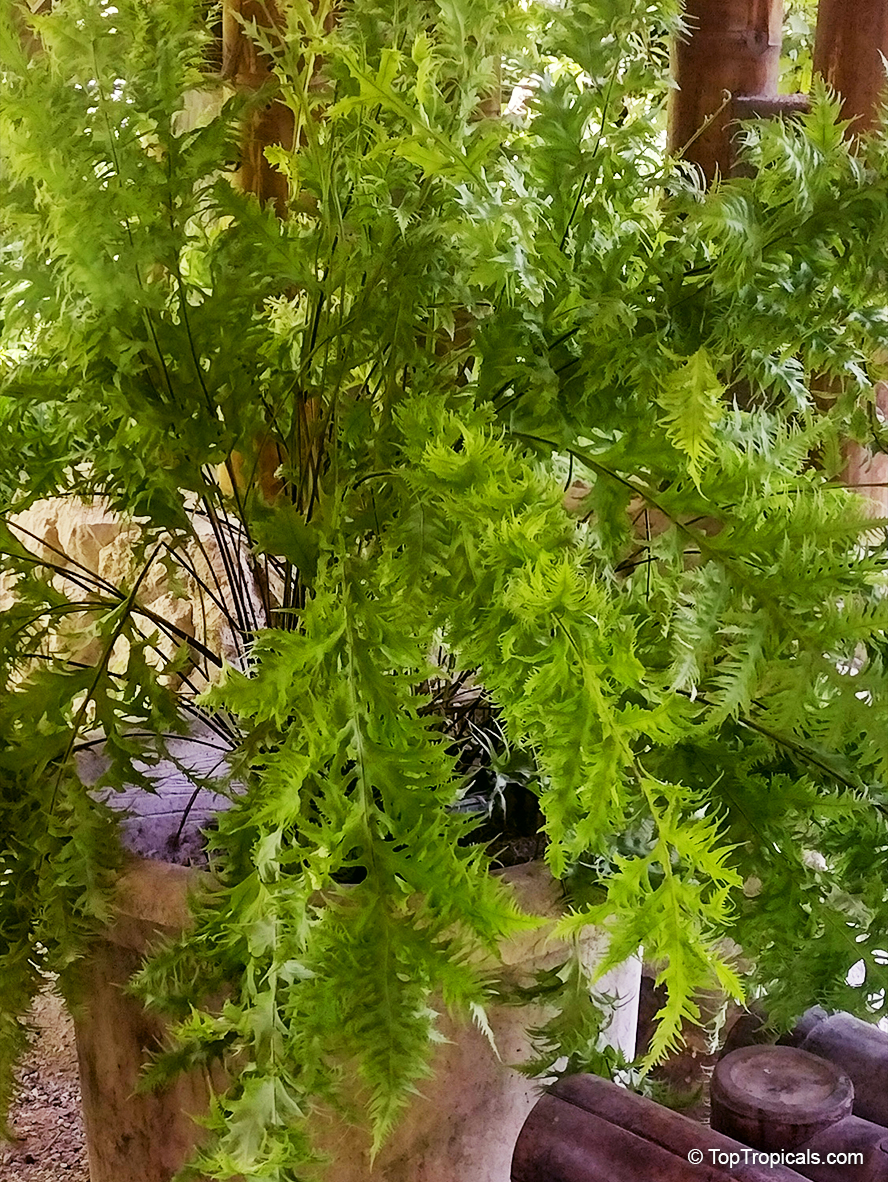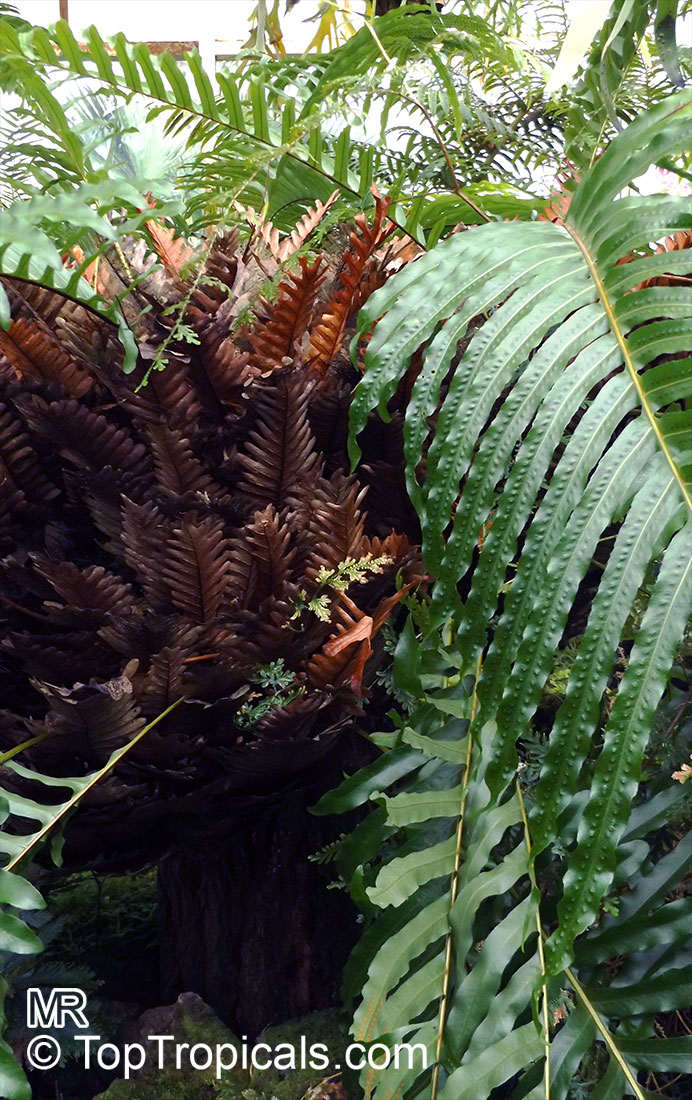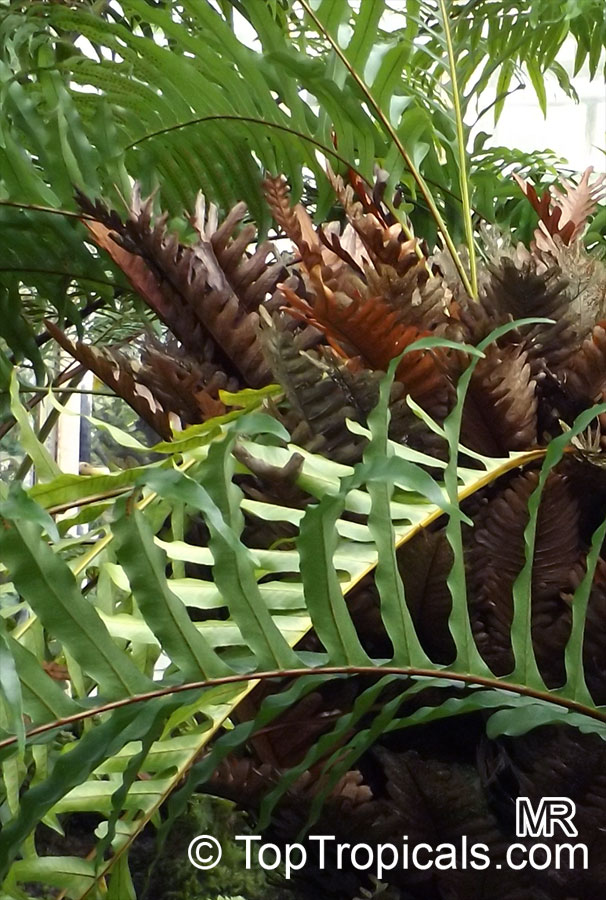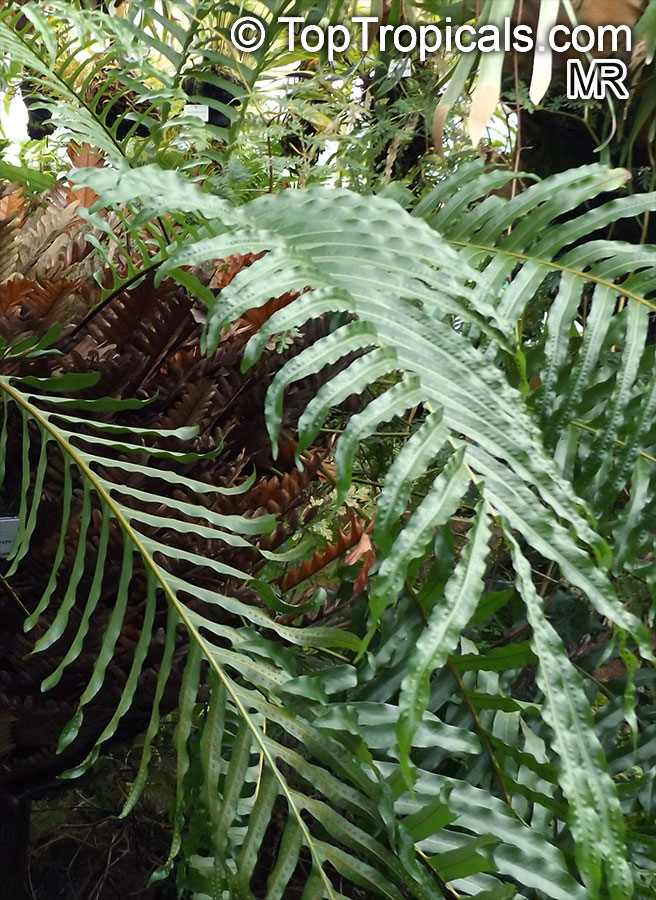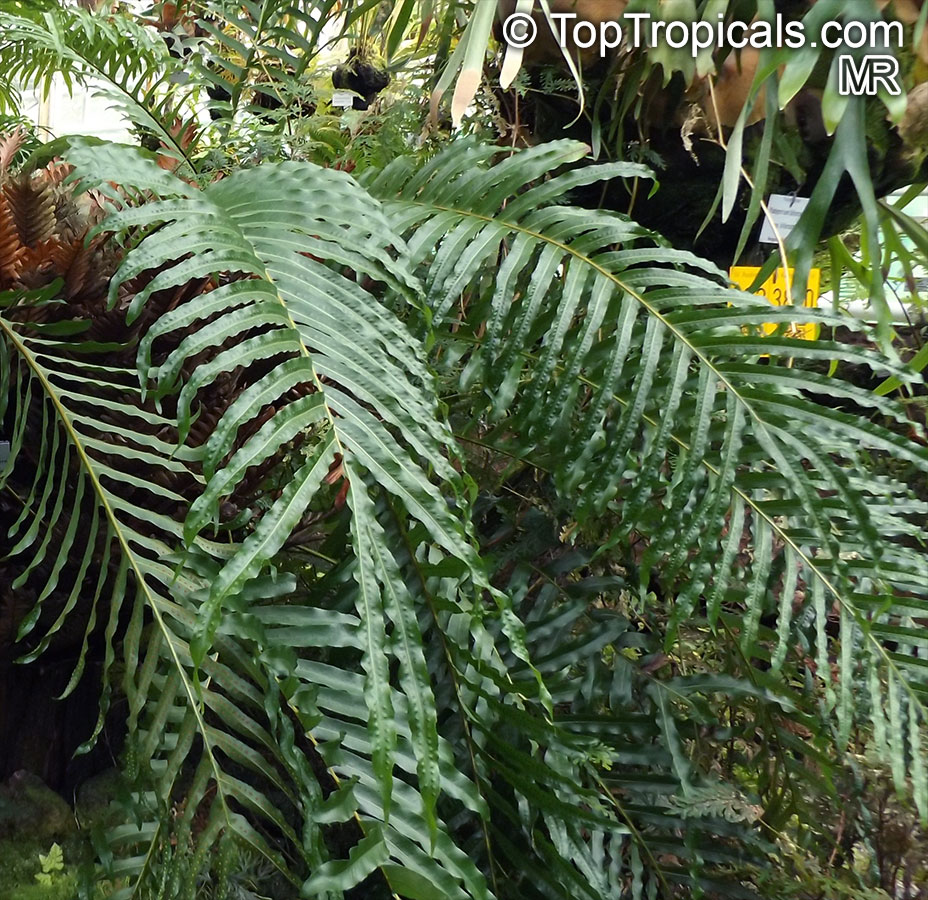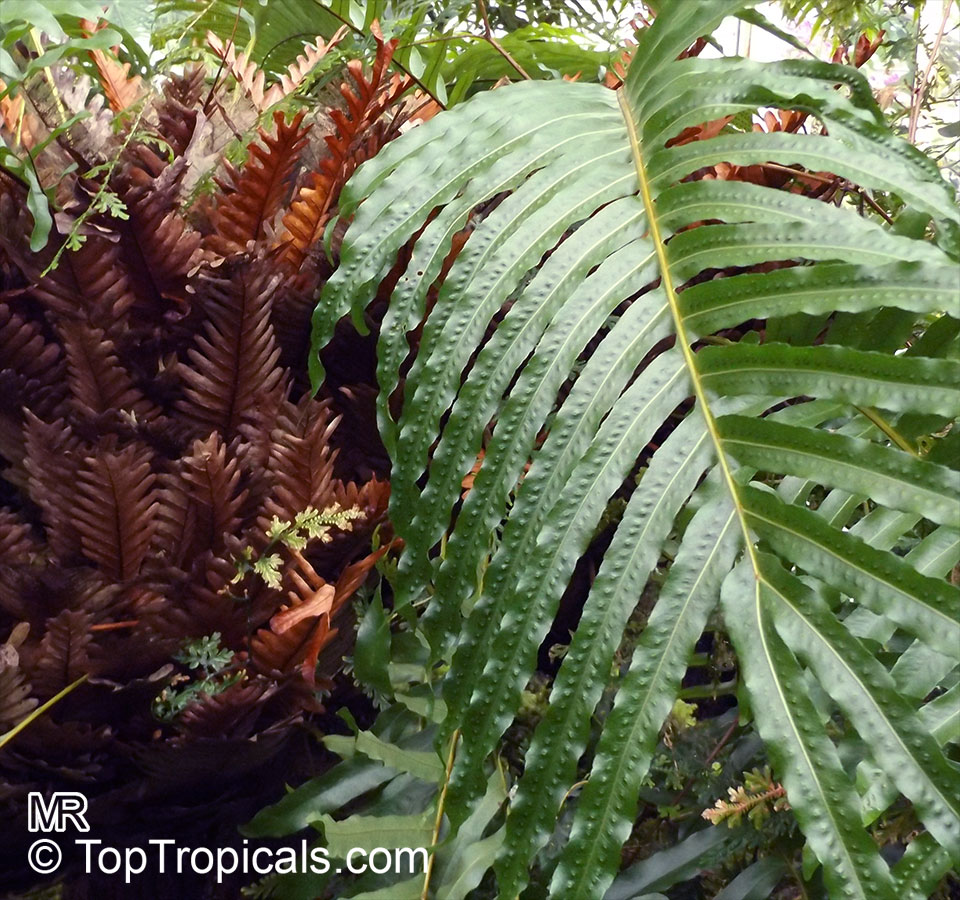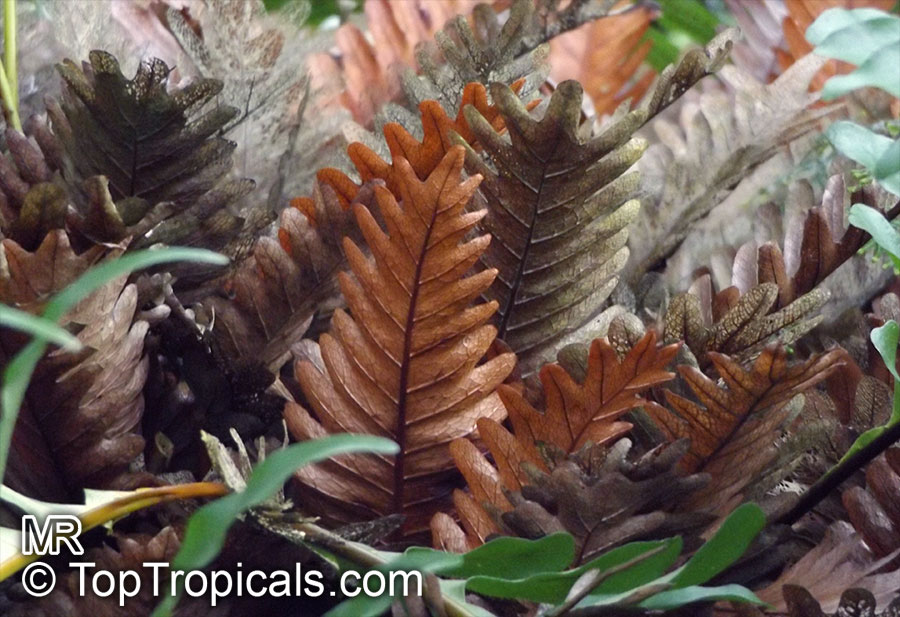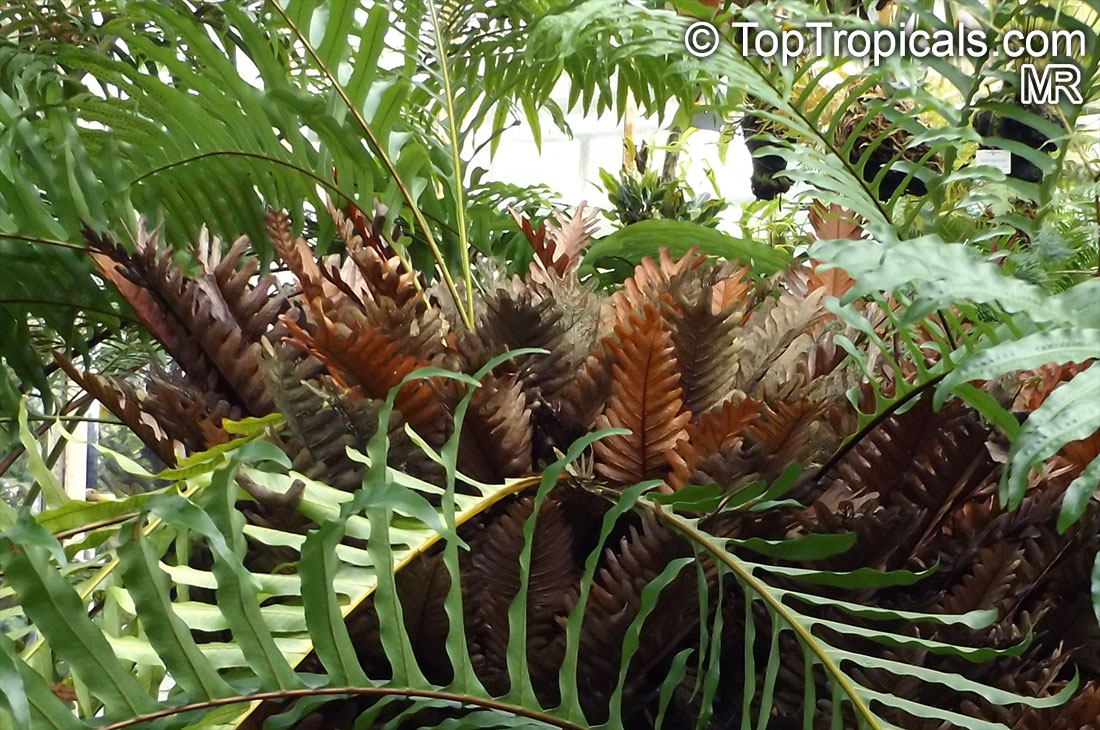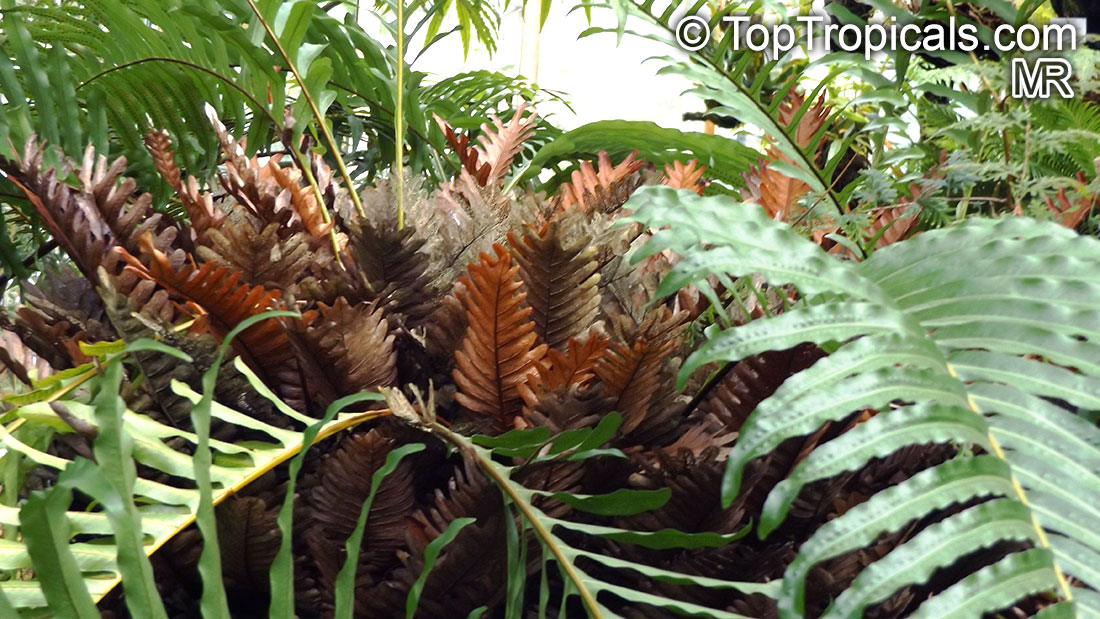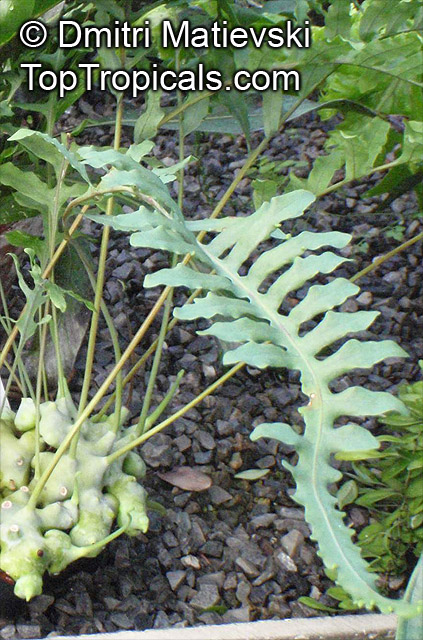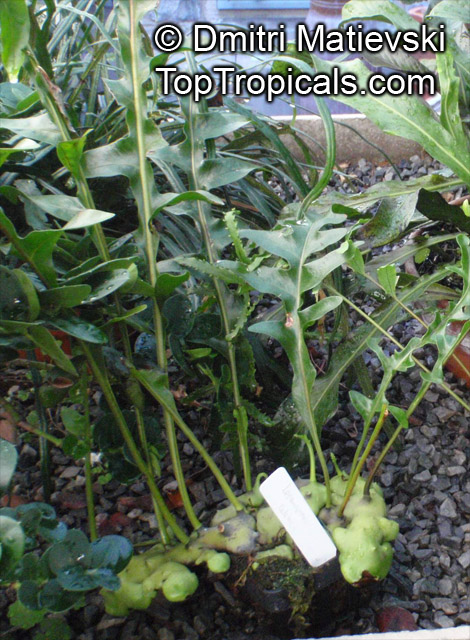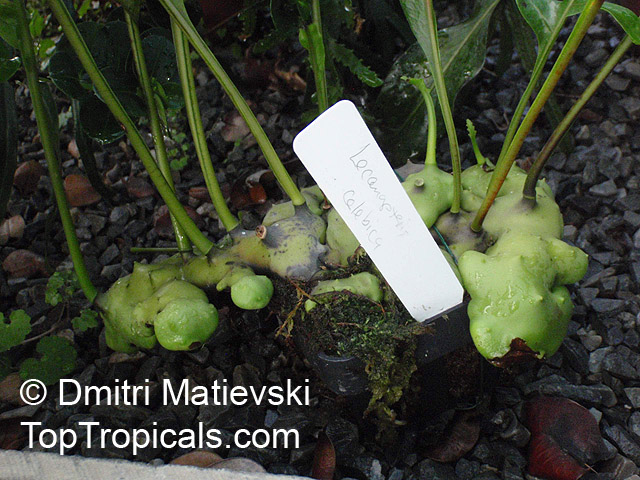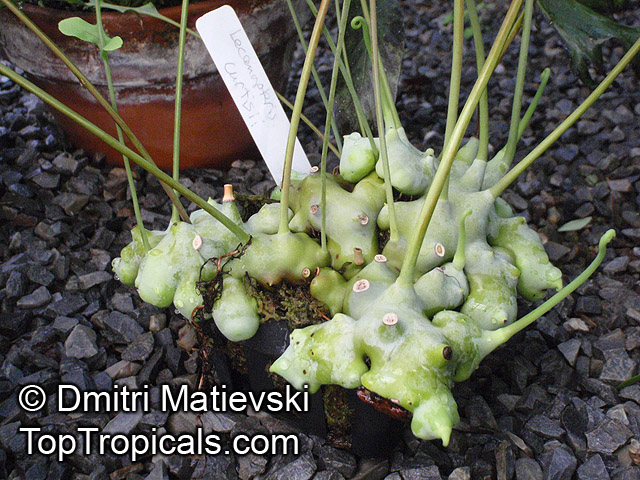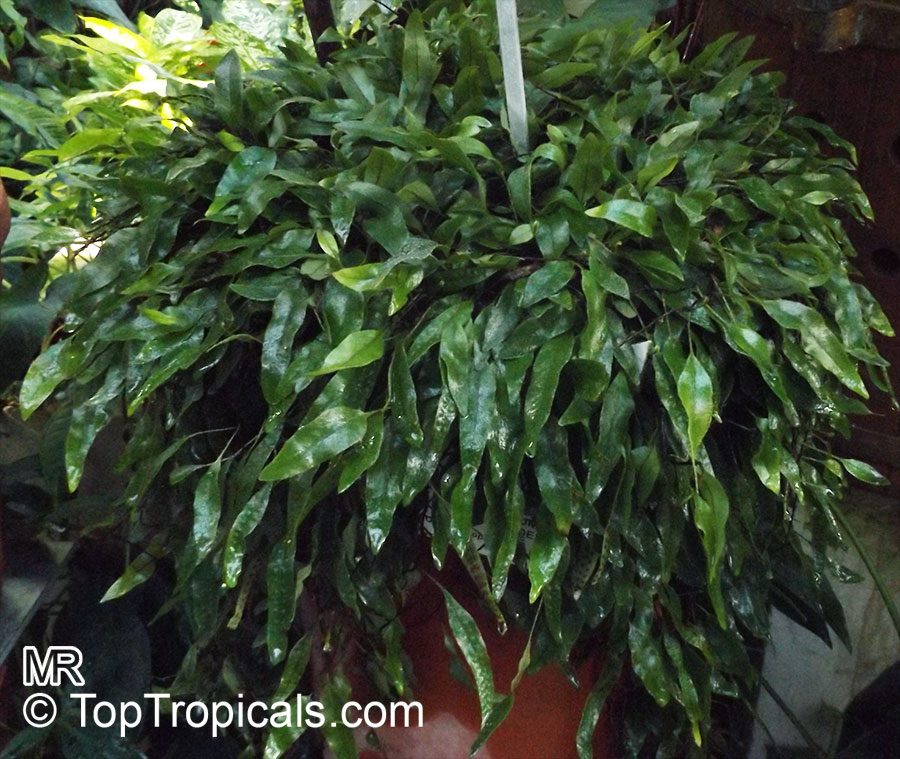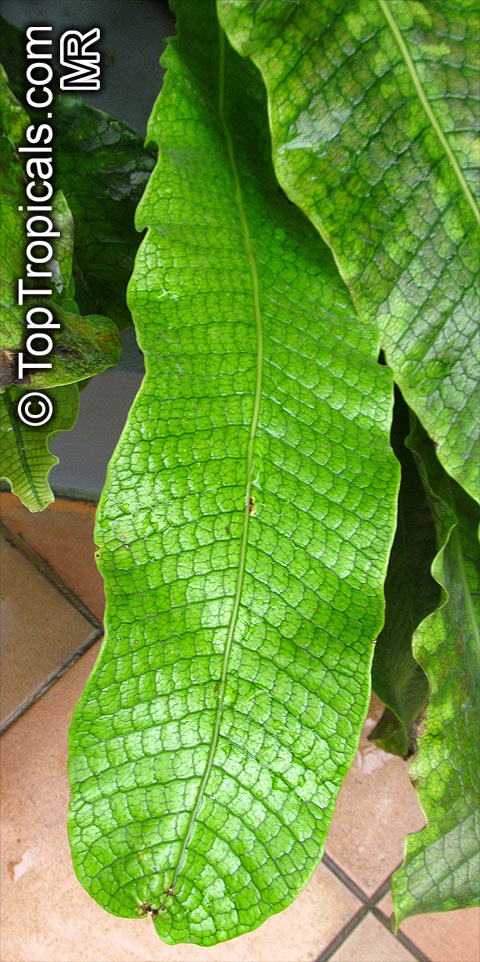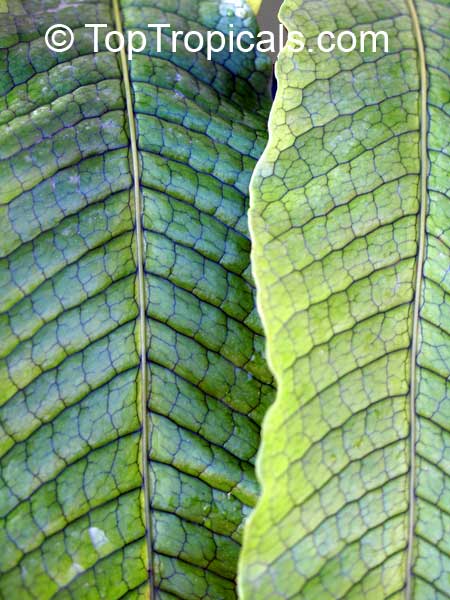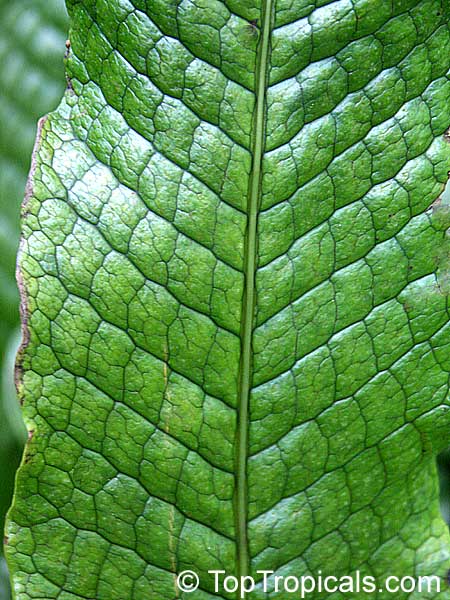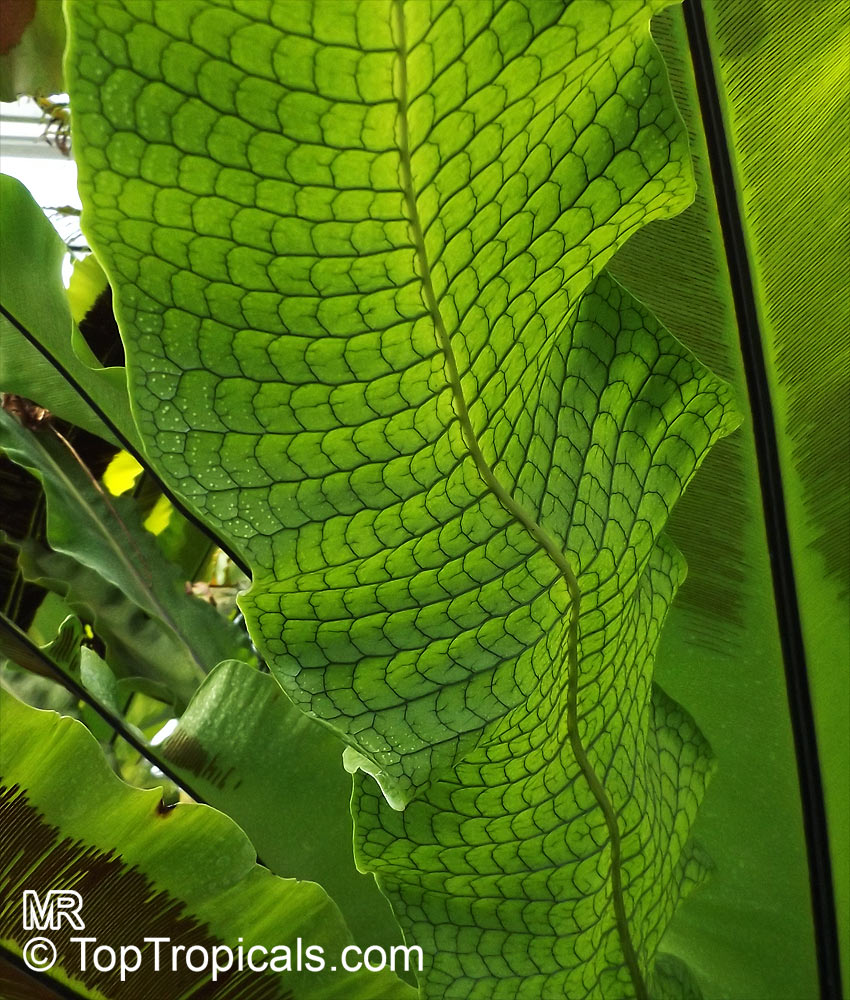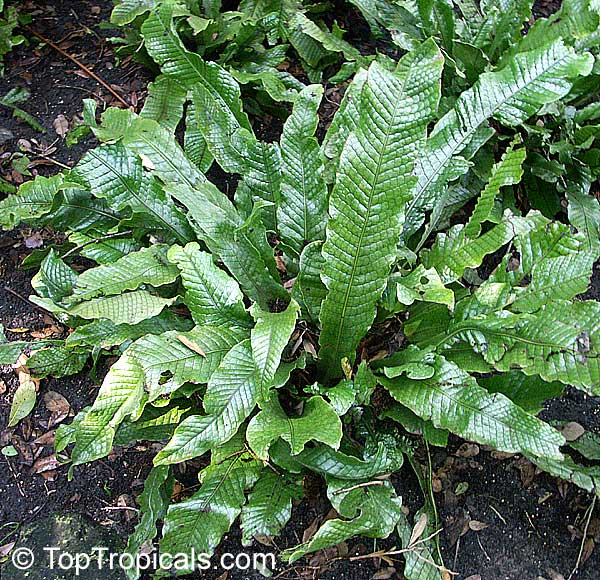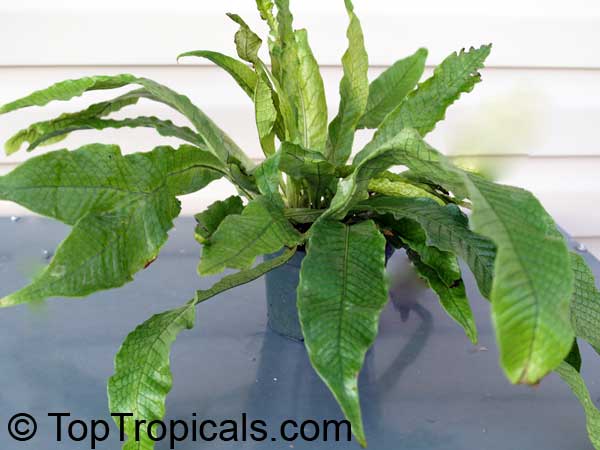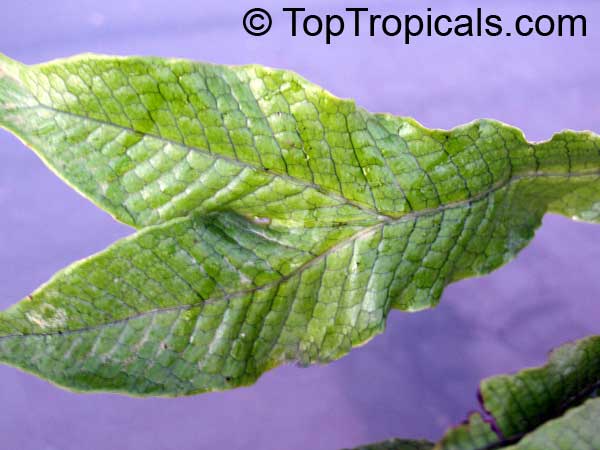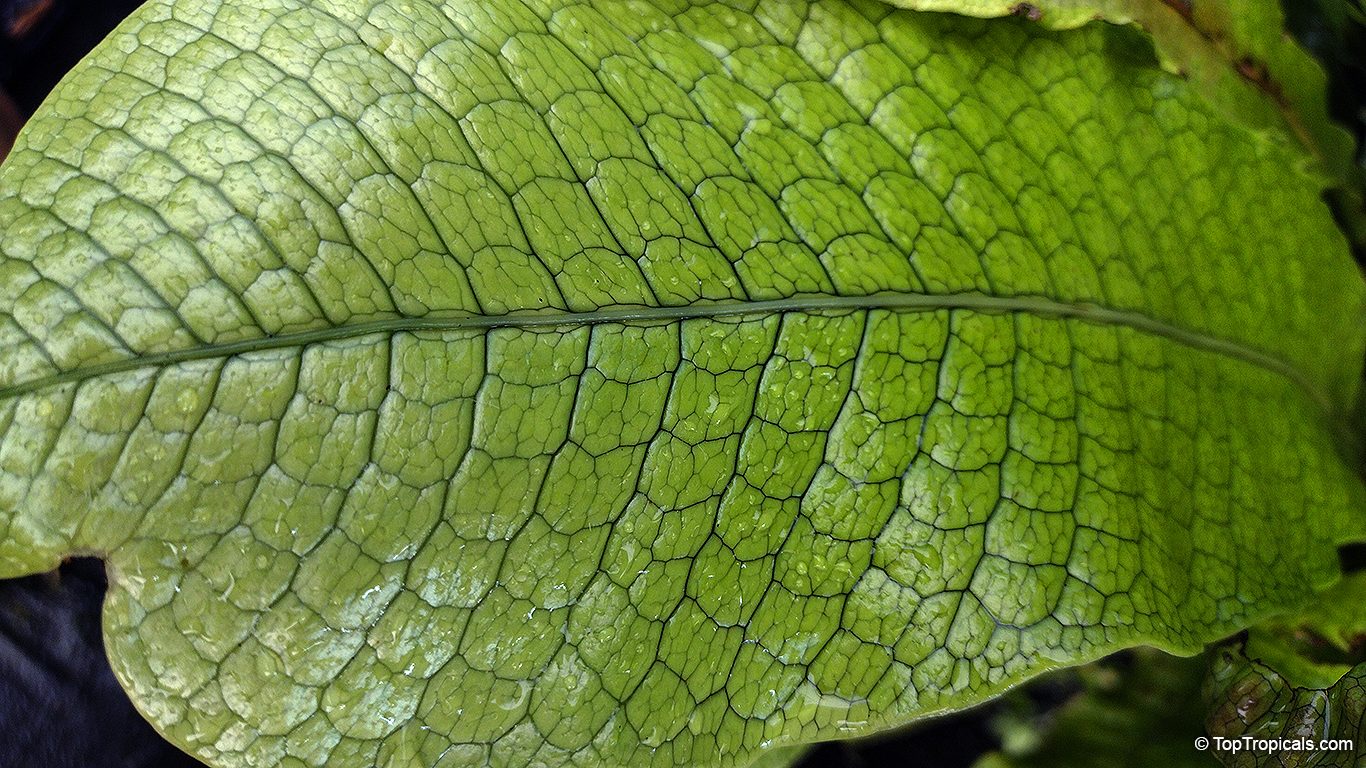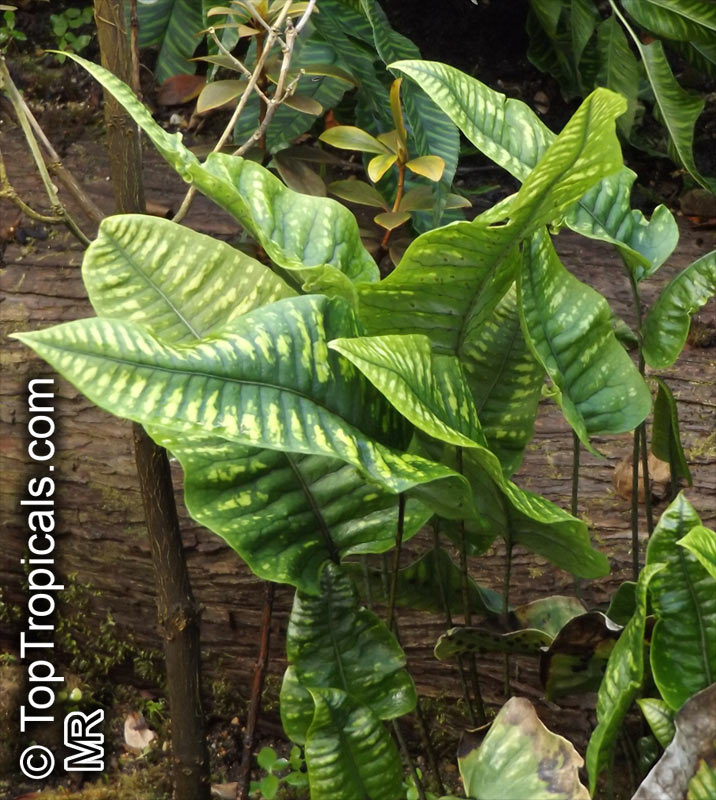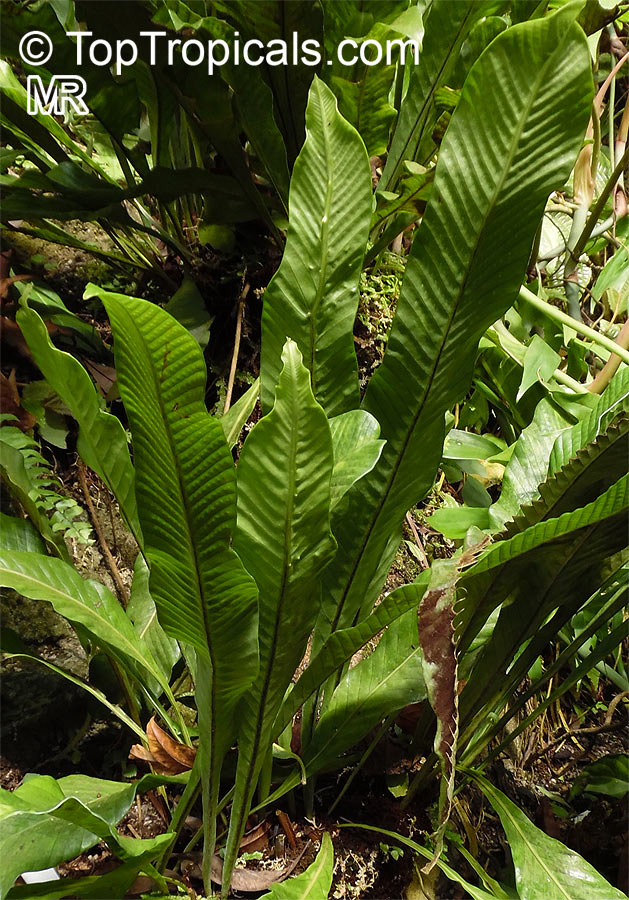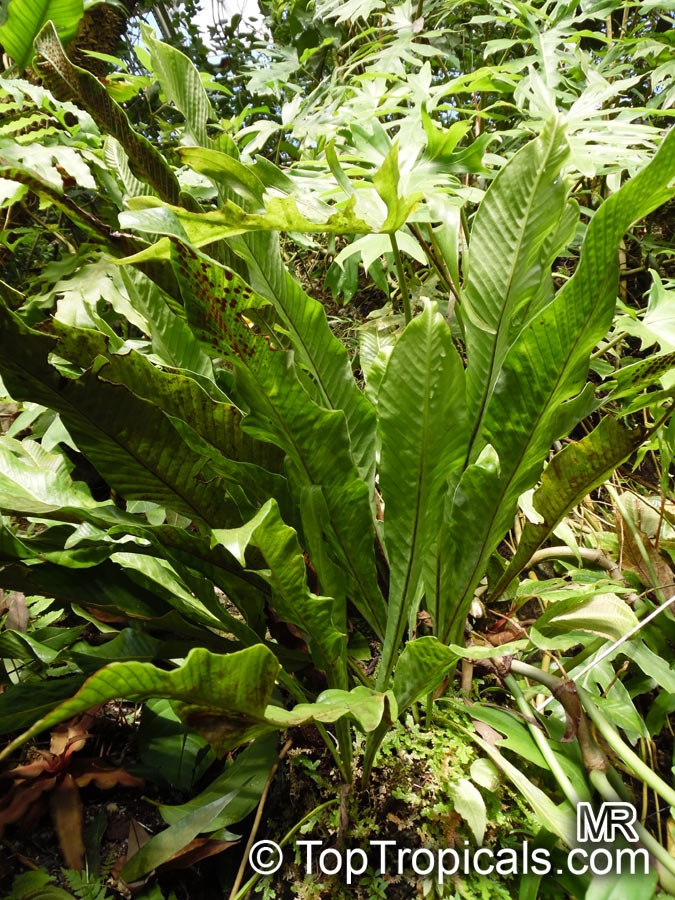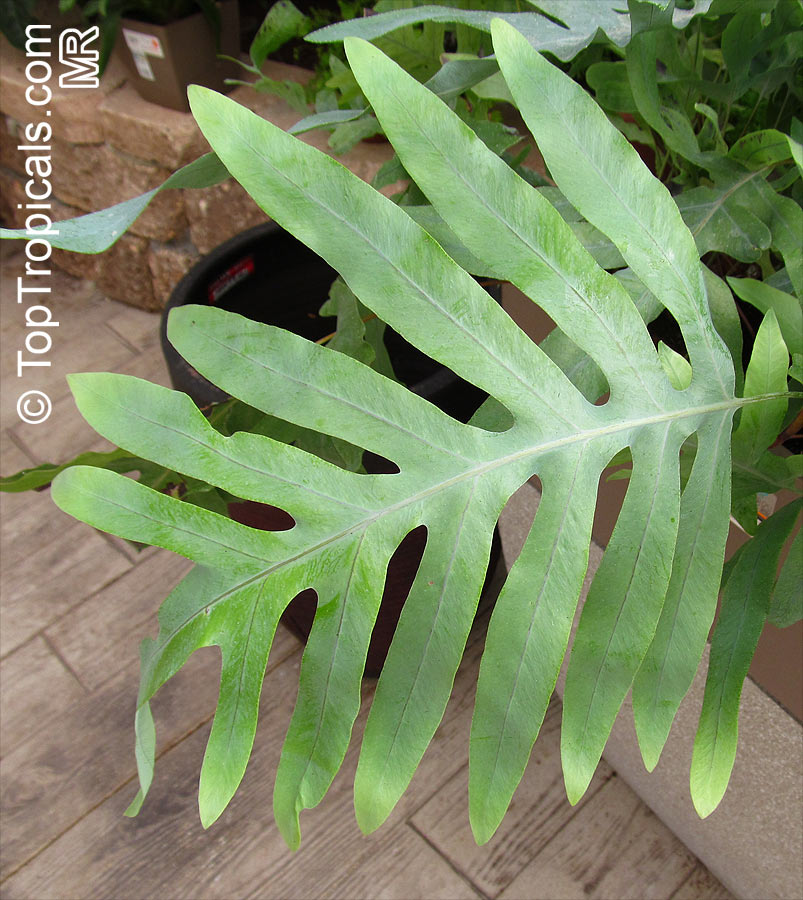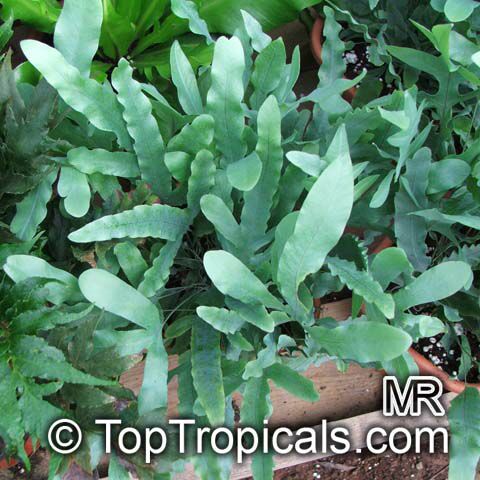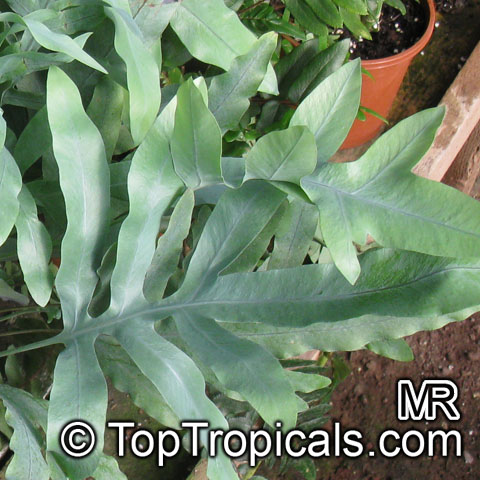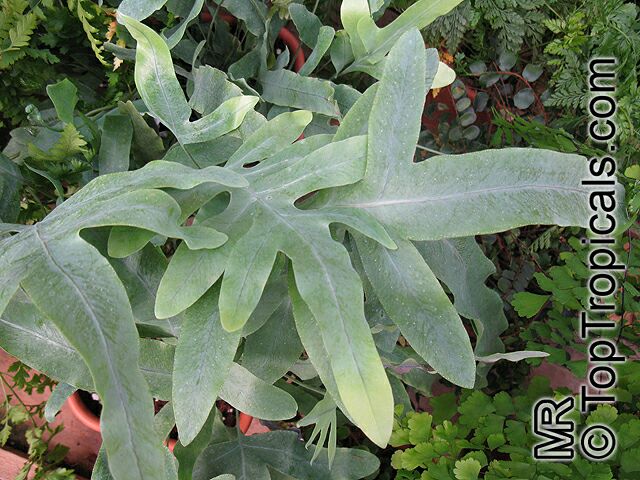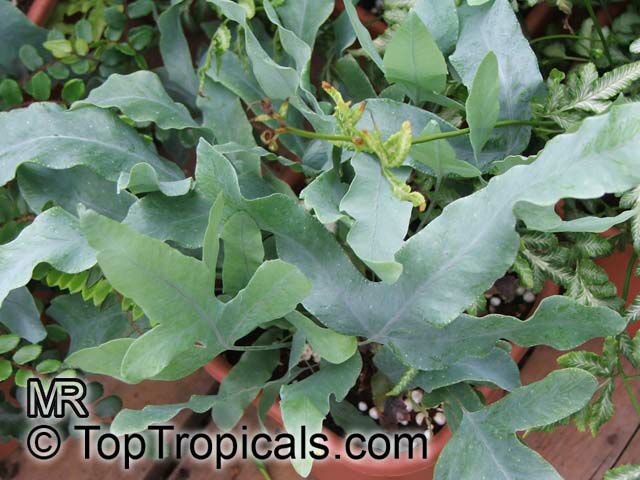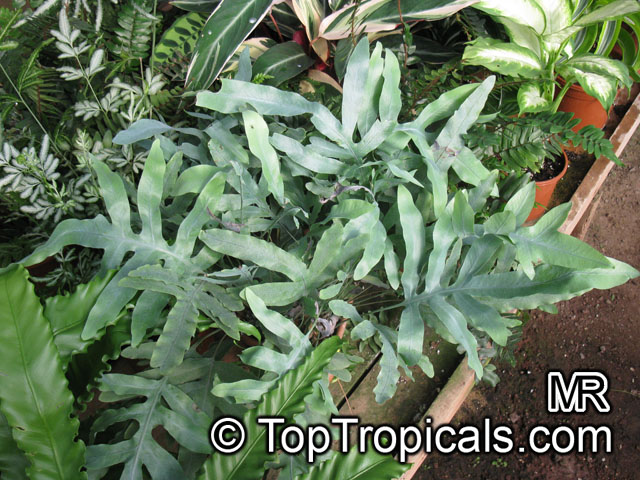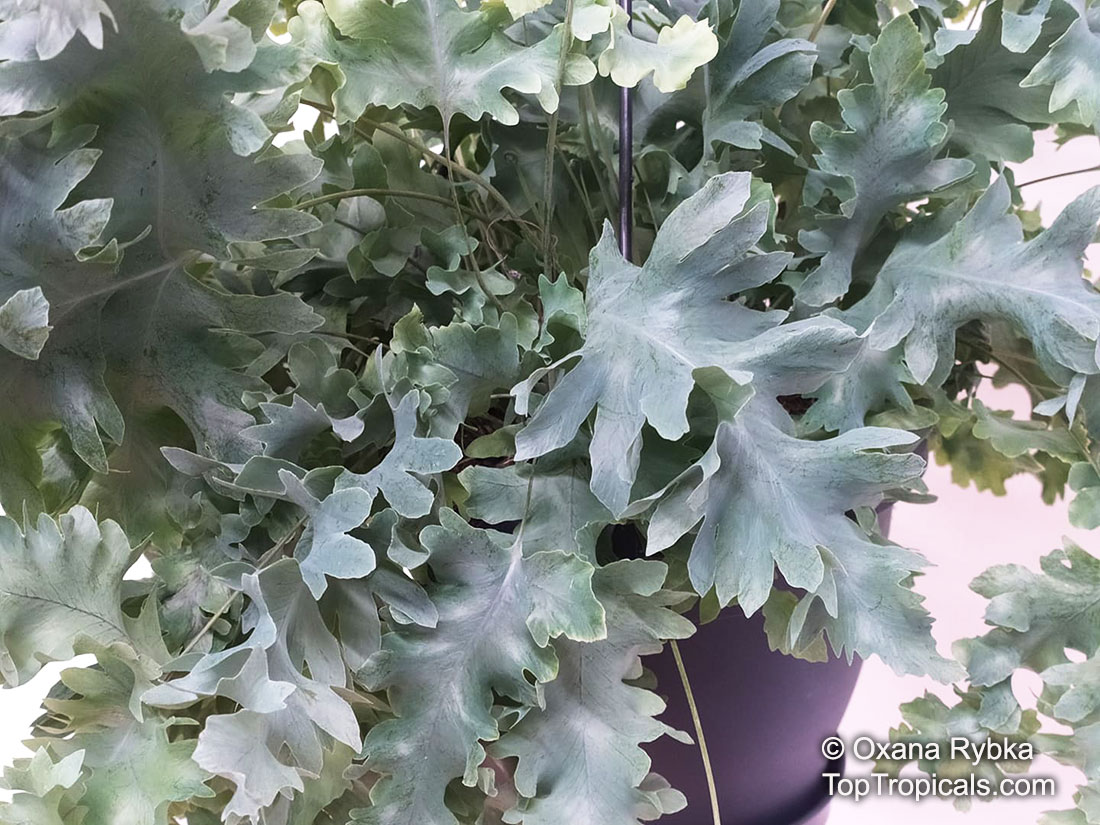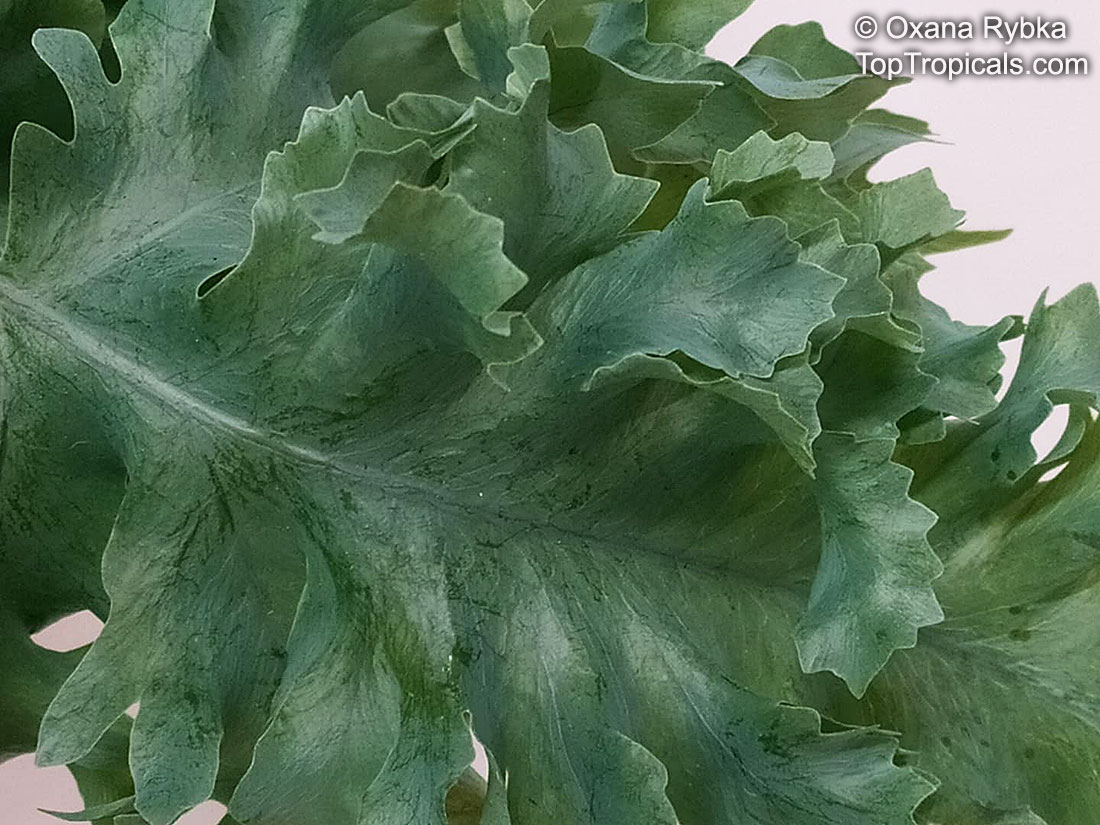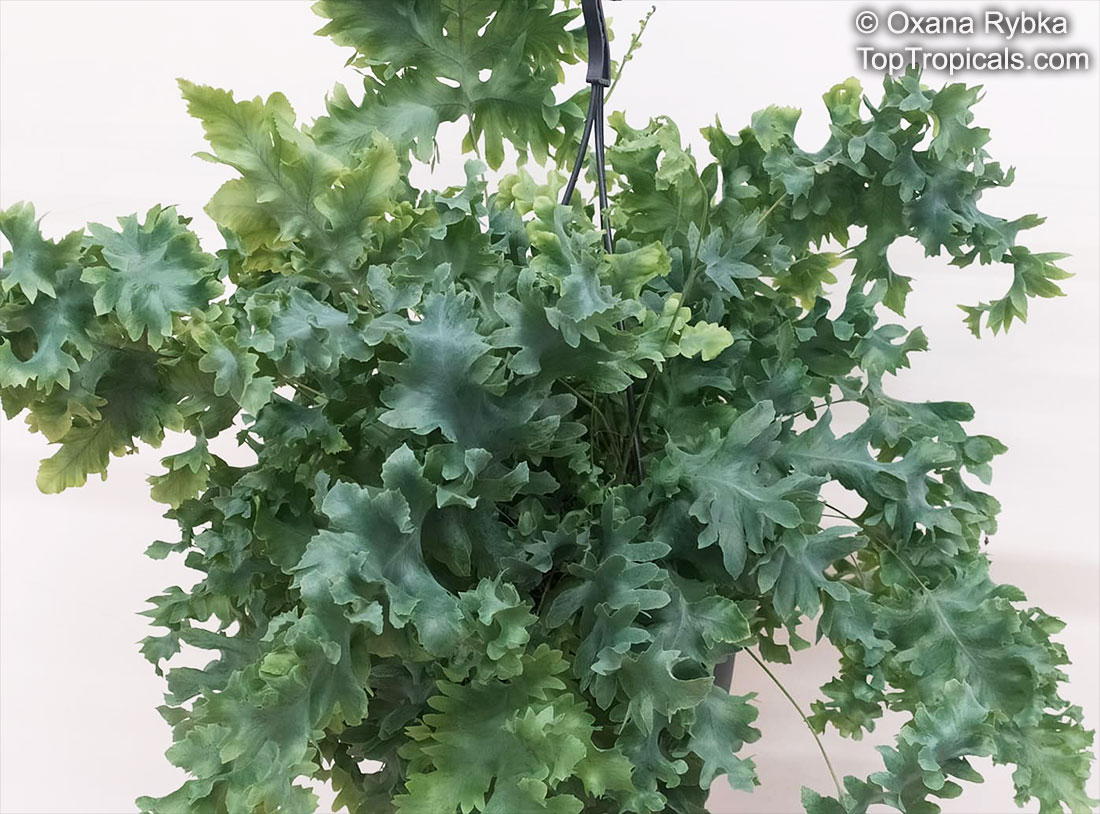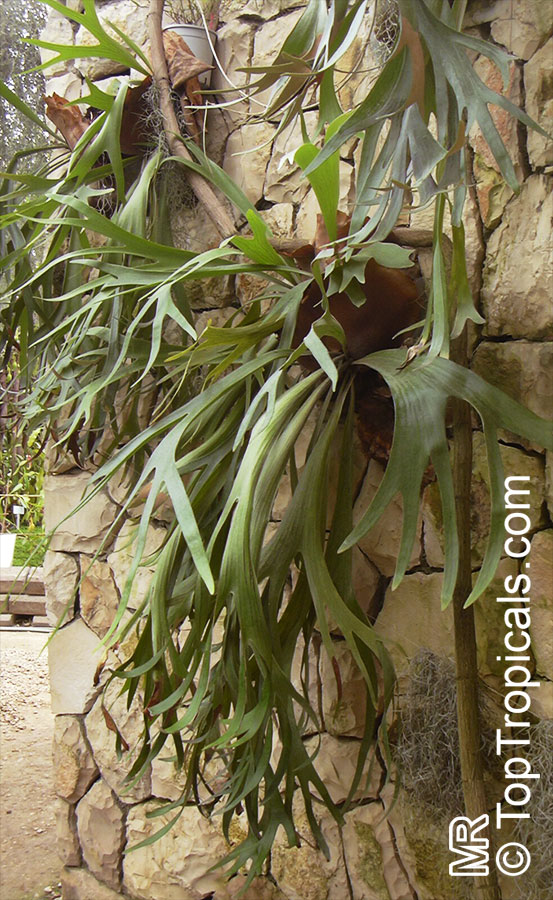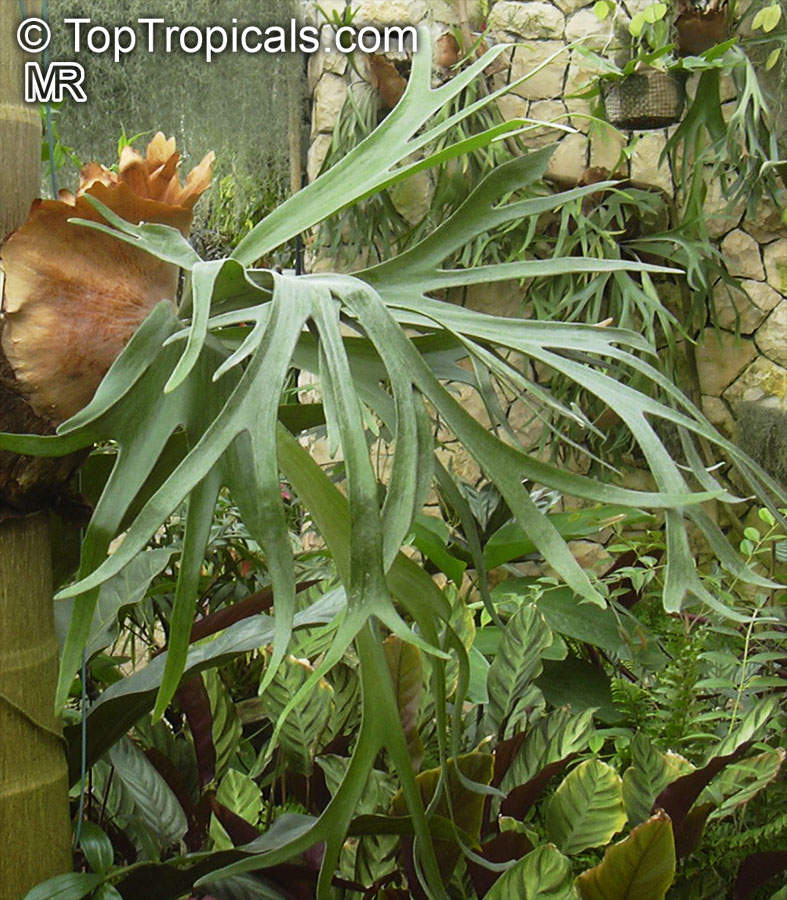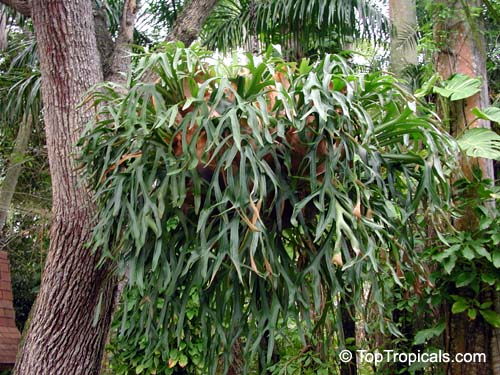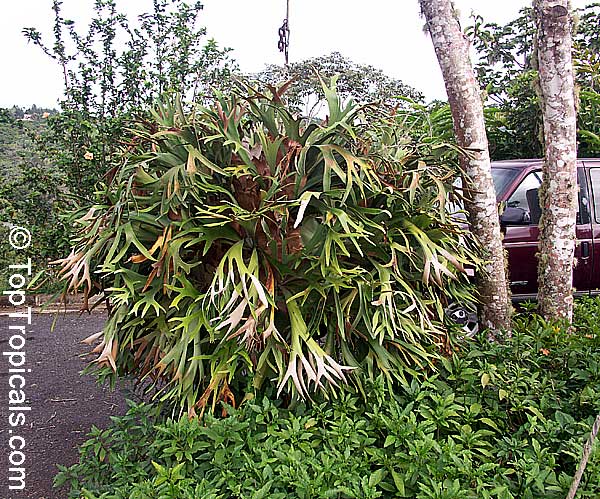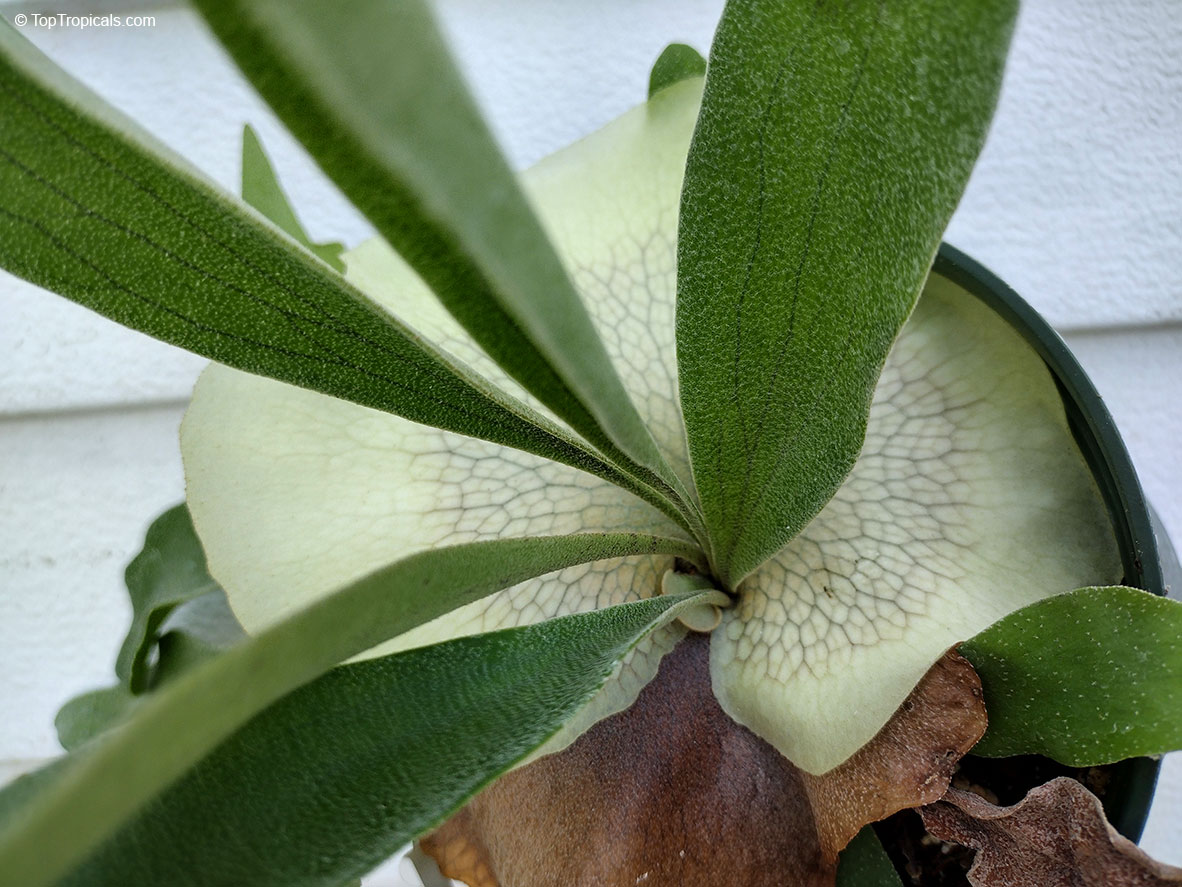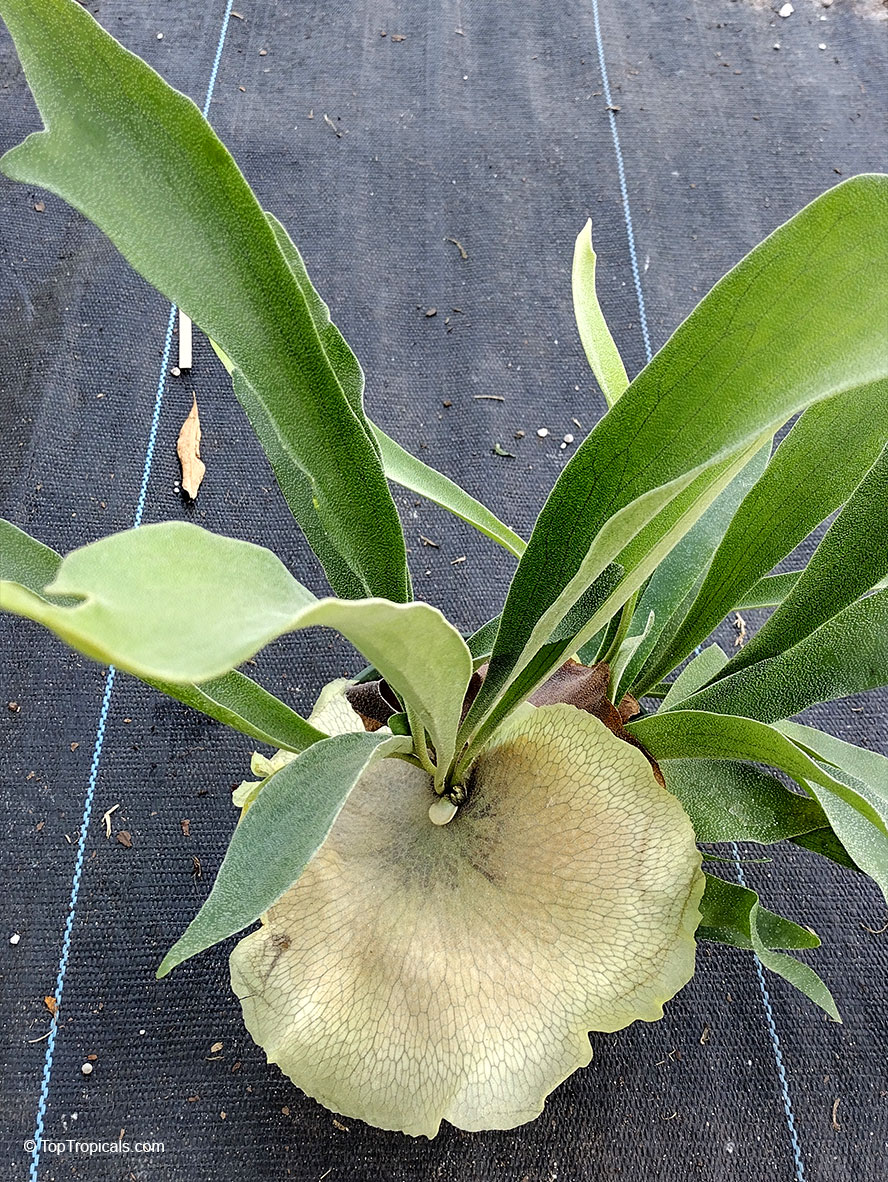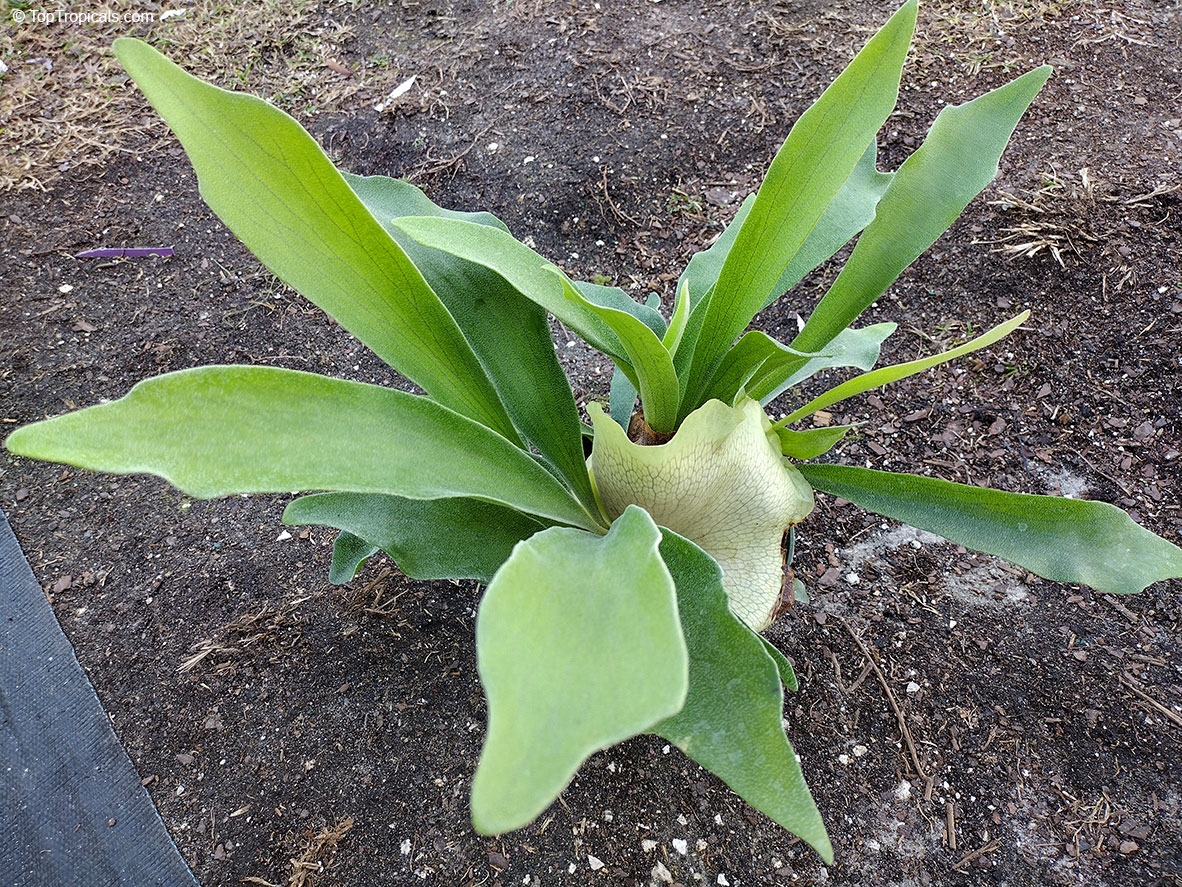Polypodiaceae - Botanical Family
Top Tropicals Plant Encyclopedia
| Number of plants found: 18 | Next | 
|
Go to page: | 1 | 2 |
Botanical names: Drynaria rigidula, Polypodium rigidulum
Common name: Basket Fern
Family: Polypodiaceae
Origin: East Asia






Drynaria rigidula (Basket Fern) can be grown in USDA Zone 9-12 outdoors, but it does need protection from harsh winters. It grows well in semi-shade position, in a well-draining, moisture-retentive soil. During the growing season, it prefers regular watering and occasional misting. To grow in cold regions, it is best to keep the plant in a pot and move it indoors during winter time. It also benefits from occasional fertilizing with an organic fertilizer during the growing season. This plant is a seasonal plant has leafless dormancy period during December-March and need less water.
Drynaria rigidula has great ethnomedical importance. It has been used in traditional medicine to treat various ailment. In addition to the medicinal benefits, it is also a popular ornamental plant and is often used in rock gardens, pots, or hanging containers to add texture and interest to any garden space.
Botanical names: Drynaria willdenowii, Polypodium willdenowii
Common name: Basket Fern
Family: Polypodiaceae
Origin: Mauritius, Madagascar





Basket ferns are epiphytic (growing on trees) or epipetric (growing on rocks and brick walls).
Basket ferns are characterized by the presence of two types of fronds, fertile foliage fronds and sterile nest fronds. The dark green foliage fronds are large, 2-4 feet (0.61-1.22 m) long, with elongated stalks. They are deeply lobed or pinnate, winged, and bear sori (structures producing and containing spores) on the bottom surfaces.
The nest fronds are smaller rounded leaves basal to the foliage fronds. They do not bear sori and are persistent, not being shed after turning brown and dying. They form a characteristic 'basket' that collect litter and organic debris, hence the common name.
Botanical name: Lecanopteris celebica
Common name: Ant Fern
Family: Polypodiaceae
Origin: Sulawesi, Indonesia






Originating from the high humidity of Sulawesi, Indonesia, Lecanopteris celebica (Ant Fern) is a unique and beautiful fern with lush, ornamental foliage. It is a small plant, typically growing between 2 and 5 ft tall and is an interesting conversation piece for any garden. As a tropical epiphyte, it requires warm temperatures, high humidity, and access to partial shade or even semi-shade - and it loves to live in trees or on logs.
This unique fern has an interesting addition to its anatomy, that being hollow caudexs which ants use to live and thrive in. These ants are considered symbiotic to the plant and help with pollinating, eating and removing pests, and providing nutrients to the soil.
The Lecanopteris celebica is hardy in zones 9-11, making it suitable to be grown outdoors in many areas. Proper care is important, though. This plant must be kept moist and heavily misted to replicate its natural environment. If you live in an area with a cooler climate, you can still grow it in a pot indoors or outdoors. Some protection must be provided to shield it from the cold, and a humidifier can help replicate the humidity of its native environment. It should be kept away from direct sunlight and its soil should be changed about once a year.
Overall, if you live in the proper climate, or have the resources to provide proper care and protection from the cold, this unique and vibrant fern is a great addition to any garden or indoor setup. Its unique caudex is sure to be a conversation starter, and with proper care and attention, it's sure to bring a slice of tropical paradise to your living space.
Botanical names: Microgramma piloselloides, Polypodium piloselloides
Common name: Hairy Snakefern
Family: Polypodiaceae
Origin: Central and South America





Botanical name: Microsorum musifolium
Common names: Alligator Fern, Crocodile Fern
Family: Polypodiaceae
Origin: Australasia






Growing best at 55F and higher temperature, it is an ultra-tropical mini-shrub, gaining 2-5 feet in height. Microsorum musifolium is perfect as a houseplant, or planted in locations with live oak, hickory and pine. It has a fast growing rate so regular water is needed.
Microsorum musifolium (Alligator Fern) makes an attractive addition to any landscape. A fast growing, evergreen tropical fern, it can grow to a maximum of 2-5 ft in height and likes a sheltered, semi-shaded location with light but not direct sunlight.
Receiving regular water is key and it should be watered in the morning or evenings in hotter climates. It can even be grown in cooler climates in a pot, either brought in for the winter or kept outside in a sheltered place.
The strikingly shaped, light green fronds of the fern form a lovely backdrop to its stunning stiff, leathery, dark green alligator-skin foliage. This unique leaf shape is the main reason for its popularity, particularly among the horticultural enthusiasts. As the fern grows, it will produce small structures known as rhizomes, anchoring it firmly to the ground, however be careful not to give too much space to allow running, as it may spread further than expected.
A bright, airy location with good air circulation is all that's needed to grow Alligator Fern. It is an ideal plant for a north-facing window with no direct sunlight and prefers ericaceous compost, being especially good in terrariums and hanging baskets. A regular misting to keep the fronds hydrating and adding dolomite lime to your potting mix, will ensure a healthy long-term growth of this beautiful fern.
Botanical name: Niphidium crassifolium
Common name: Graceful Fern
Family: Polypodiaceae
Origin: Central America, South America






It is a small shrub, usually growing 2-5ft tall. Niphidium crassifolium will grown best in semi-shade and be provided with moderate water when planted.
Niphidium crassifolium has an ornamental foliage, with leathery fronds that can be up to 12 inches wide, in clumps grouped around the branch tips of the shrub. The fronds become larger and a darker green as the plants mature. It has been used in Ethnomedical practice as anti-inflammatory, for ulcers and for uterine cysts and disorders.
When growing in cold regions, Niphidium crassifolium is a reliable pot plant and can be grown in USDA Zones 9-11. The mature plant can tolerate cold temperatures of at least 30F for a short period, but it's best to move the plants indoors during cold and wet periods. It can be grown indoors provided there is plenty of sun provided. The pot and soil should be well-drained and never allowed to become soggy, as root rot quickly sets in. Water should also be provided in moderation and every few days, with an occasional misting over the leaves. In addition, Niphidium crassifolium can be propagated; this is easy to do and can be achieved through simple division or through the use of fresh spore or sterile leaves.
Niphidium crassifolium requires a sunny or semi-shaded area to grow and keep moist but not soggy soil. The plants should be fertilized monthly with a balanced fertilizer and given additional iron and zinc if the soil is not particularly rich. Pruning is necessary whenever the plants grow beyond their desired size. Take care not to prune too much, as this can damage the plant. By taking these simple steps, the Niphidium crassifolium can be maintained and enjoyed for years to come.
Botanical names: Phlebodium aureum, Polypodium aureum, Polypodium leucotomos
Common names: Golden Polypody, Golden Serpent Fern, Cabbage Palm Fern
Family: Polypodiaceae
Origin: Tropical America





Botanical names: Platycerium bifurcatum, Platycerium alcicorne
Common names: Elkhorn Fern, Staghorn
Family: Polypodiaceae
Origin: Australia and New Guinea





It is able to grow in a variety of habitats from high in the trees of the rainforest to areas of swamp and open forest. It often grows in large masses on boulders and rock faces in New South Wales, and on trees in Queensland. Platycerium bifurcatum need bright indirect light. New divisions should be misted daily to keep the humidity levels high. Once they are established, the ferns are fairly drought tolerant and should be watered at least twice a week during the growing season. Fertilize on a monthly basis for established ferns. During the winter rest period, water only enough to keep the fronds from wilting. Too much water in winter causes spotting of the fronds.
SIMILAR SPECIES: Platycerium coronarium has fertile leaves forked up to 7x (vs. forked to 5x), and sporangia on rounded or kidney-shaped lobes (vs. on terminal tapering lobes).
Botanical name: Platycerium coronarium
Common names: Stag's Horn Fern, Staghorn
Family: Polypodiaceae
Origin: SE Asia







Showy, tropical looking epiphyte that can be grown on a tree or in a large hanging basket. Long, pendulous, much bifurcated fertile fronds produce spores on special cup shaped appendages. Basal fronds form a crown shaped basket. It is able to grow high in the trees of the rainforest, often grows in large masses. Needs bright indirect light. New divisions should be misted daily to keep the humidity levels high. Once they are established, the ferns are fairly drought tolerant and should be watered at least twice a week during the growing season. During the winter rest period, water only enough to keep the fronds from wilting. Too much water in winter causes spotting of the fronds.
SIMILAR SPECIES: Platycerium bifurcatum has fertile leaves forked up to 5x (vs. forked to 7x), and sporangia on terminal tapering lobes (vs. on rounded or kidney-shaped lobes). P. coronarium and P. bifurcatum which look alike when young.
| Next |  |
Use link to repeat this search:
https://toptropicals.com/cgi-bin/garden_catalog/cat.cgi?search_op=and&keyword_op=and&language=e&family=Polypodiaceae
&number=10&no_change_lang=1&user=tt&sale=1&first=0
